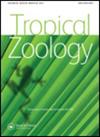尼日利亚尼日尔三角洲豹(Panthera pardus)最新分布资料及保护现状
IF 0.7
4区 生物学
Q4 ZOOLOGY
引用次数: 3
摘要
豹(Panthera pardus)在西非日益受到威胁,显然非常罕见,在尼日利亚的大部分地区已经濒临灭绝。在尼日尔三角洲,它被认为受到了极大的威胁,在过去的几十年里很少有人看到它。在本研究中,我们记录了豹子存在的直接(皮肤、足迹、粪便等)和间接(村庄猎人访谈)迹象,以重建2000-2015年期间尼日尔三角洲的豹子存在。将数据合并为2000-2002年、2006-2008年和2012-2015年三个调查期,并与1996-1997年的文献数据进行比较。2.2-4.3%的村庄(n = 39-62)有新皮肤记录。此外,据猎人报告,在另外3.3-10.3%的村庄中也发现了美洲豹。总体而言,三角洲的一些特定区域经常成为豹子存在的直接和间接迹象的目标(沿尼日尔河中轴线的屏障岛和洪水林),但所有直接目击都发生在少数屏障岛上。在尼日尔三角洲,几十年来没有母豹带着幼崽的证据,只有几张皮是目前豹子存在的唯一直接迹象。我们的研究结果表明,在尼日尔三角洲,豹子种群可能已经功能性灭绝,只有少数流浪的个体在分散和/或狩猎中仍然存在。堰洲岛的森林显然是三角洲最后一个可能仍有豹子居住的植被区,在未来的几年里,它们应该得到仔细的管理。本文章由计算机程序翻译,如有差异,请以英文原文为准。
Recent distribution data and conservation status of the leopard (Panthera pardus) in the Niger Delta (Nigeria)
The leopard (Panthera pardus) is increasingly threatened in West Africa, and is apparently very rare and has been driven to extinction across much of Nigeria. In the Niger Delta, where it is considered extremely threatened, with very few sightings in the last decades. In this study we document both direct (skins, footprints, scats, etc.) and indirect (village hunter’s interviews) signs of leopard presence in order to reconstruct leopard presence in the Niger Delta, across the period 2000–2015. Data were combined into three survey periods: 2000–2002, 2006–2008 and 2012–2015, and compared with literature data for 1996–1997. Recent skins were recorded in 2.2–4.3% of the villages (n = 39–62). In addition, the leopard was reported to be present by hunters in another 3.3–10.3% of the villages. Overall, some specific sectors of the Delta were recurrently target of both direct and indirect signs of leopard presence (barrier islands and flood forest along the central axis of the River Niger), but all direct sightings occurred in a few barrier islands. In the Niger Delta, there was no evidence of females with cubs since decades and a few skins were the only direct signs of leopard’s current presence. Our results suggest that leopard populations may be functionally extinct in the Niger Delta, with just a few vagrant individuals, in dispersal and/or hunting, being still found. Barrier island forests are apparently the last vegetation zone of the Delta still potentially inhabited by leopards, and deserve careful managements in the years to come.
求助全文
通过发布文献求助,成功后即可免费获取论文全文。
去求助
来源期刊

Tropical Zoology
生物-动物学
CiteScore
2.50
自引率
0.00%
发文量
1
审稿时长
>12 weeks
期刊介绍:
Tropical Zoology is an international zoological journal publishing original papers in the field of systematics, biogeography, phylogeny, ecology and conservation of all terrestrial and aquatic animal Phyla from tropical and subtropical areas.
Only papers with new information, high quality and broad interest are considered. Single species description and checklists are not normally accepted. Review papers are welcome. The journal is owned by the Istituto di Ricerca sugli Ecosistemi Terrestri of the Consiglio Nazionale delle Ricerche, Florence, Italy (CNR-IRET) who performs research into the structure and functioning of aquatic and terrestrial ecosystems, focusing in particular on anthropogenic pressure and global change. The knowledge amassed forms the scientific basis for identifying the most appropriate protective and corrective interventions, and provides support for the bodies entrusted with formulating policies for environmental protection and recovery.
 求助内容:
求助内容: 应助结果提醒方式:
应助结果提醒方式:


